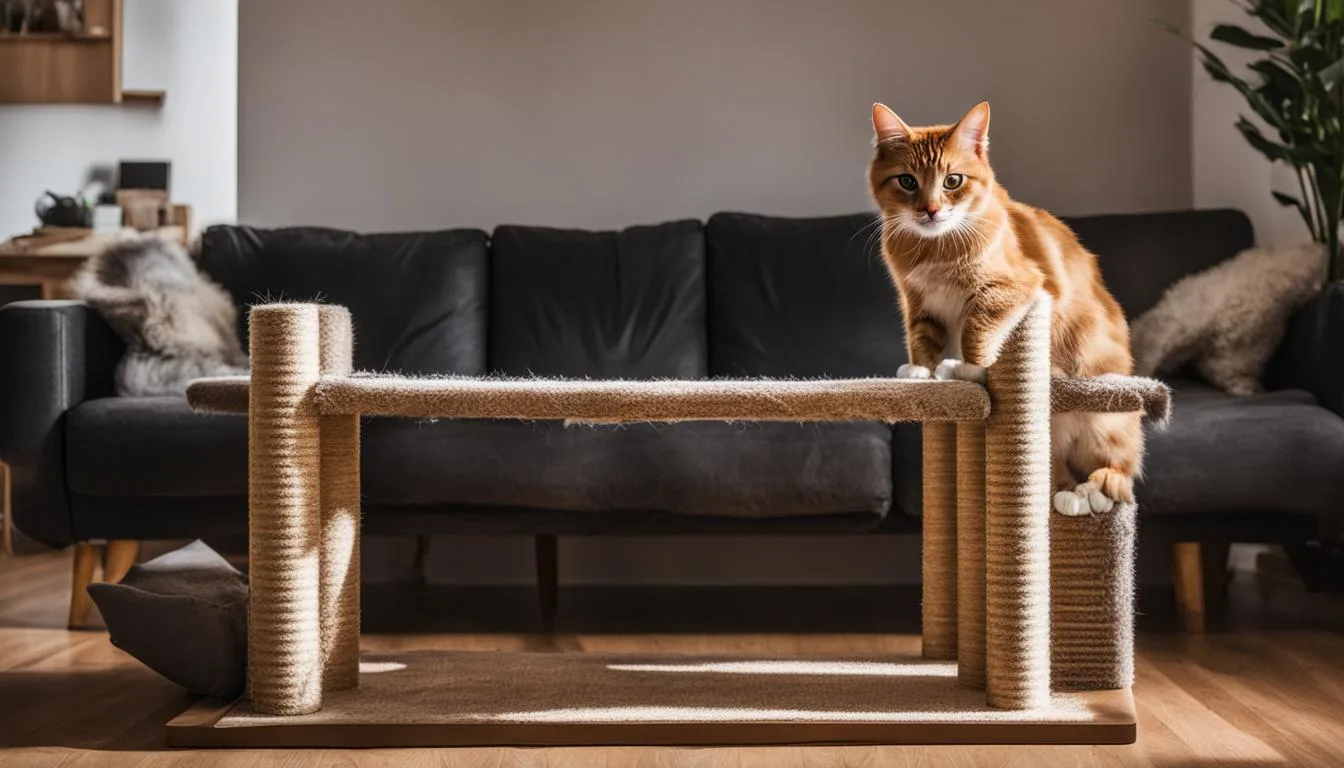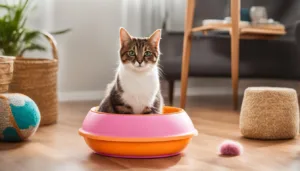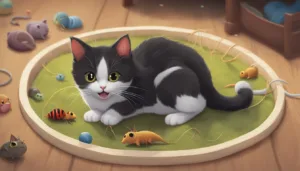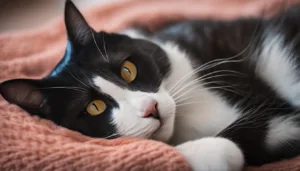Cats are beloved companions, but their natural scratching behavior can cause frustration and damage to furniture. Understanding why cats scratch and providing appropriate alternatives can help prevent this behavior and protect your belongings. In this article, we will explore the reasons behind scratching, supplies to deter cats from furniture, step-by-step instructions for redirecting their behavior, the facts about declawing, and how to repair cat scratches on leather. By mastering the art of cat care, you can create a scratch-free environment for both your feline friend and your furniture.
- Why Do Cats Scratch?
- Supplies to Stop Cat Scratching
- Step-by-Step Instructions
- The Facts About Declawing
- Types of Leather and Their Vulnerability to Scratches
- Assessing the Damage and Preparing for Repair
- Home Remedies for Fixing Cat Scratches
- Diy Repair Kits for Cat Scratches
- Conclusion
- FAQ
- Source Links
Key Takeaways:
- Understanding why cats scratch is essential for providing appropriate alternatives.
- Supplies such as scratching posts, deterrents, and toys can redirect scratching behavior.
- Declawing is inhumane and can lead to behavioral issues in cats.
- Different types of leather have varying vulnerability to scratches.
- Home remedies and DIY repair kits can be used to fix cat scratches on leather.
Why Do Cats Scratch?
Cats scratching is a natural behavior that serves various purposes, such as sharpening claws, marking territory, and expressing emotions. Understanding the reasons behind their scratching behavior is crucial for cat owners to effectively address this instinctive habit and protect their furniture.
Cats scratch regardless of their size or breed, as it is an innate behavior deeply ingrained in their nature. Vertical scratching surfaces are particularly appealing to cats, making plush furniture an easy target for their scratching sessions. By redirecting their scratching behavior to approved objects, cat owners can prevent furniture damage and provide their feline friends with appropriate outlets for their natural instincts.
To further explore the reasons behind cats’ scratching behavior, let’s take a closer look at the primary motivations behind their scratching sessions:
- Sharpening claws: Scratching helps cats shed the outer layer of their claws, keeping them sharp and healthy. It also helps cats stretch their muscles and maintain flexibility.
- Marking territory: Cats have scent glands in their paws, and scratching leaves both visual and olfactory marks to establish their territory and communicate with other cats.
- Expressing emotions: Cats may scratch to release pent-up energy, relieve stress, or communicate their emotions, such as excitement, frustration, or anxiety.
By understanding these underlying motivations, cat owners can provide appropriate scratching alternatives, such as scratching posts, toys, and interactive play sessions, which can divert their cats’ attention away from furniture and preserve the harmony between cats and their human companions.
| Reasons Cats Scratch | Examples of Alternatives |
|---|---|
| Sharpening claws | Vertical scratching posts, cardboard scratchers |
| Marking territory | Scented scratching posts, cat trees |
| Expressing emotions | Interactive toys, puzzle feeders, play sessions |
It is important to note that declawing, a procedure involving the removal of a cat’s claws, is considered inhumane and should never be pursued as a solution to furniture scratching. Not only does it cause pain and potential behavior issues, but it also deprives cats of their natural defense mechanism and can lead to long-term physical and emotional problems. Instead, focusing on providing appropriate scratching alternatives and redirecting their behavior is a more humane and effective approach for both the cat and the furniture.
To summarize, cats scratch for various reasons, including sharpening their claws, marking territory, and expressing emotions. Understanding these motivations can help cat owners provide appropriate alternatives and prevent furniture scratching. By redirecting their scratching behavior to approved objects and avoiding declawing, cat owners can maintain a harmonious living environment while honoring their feline companions’ natural instincts.
Supplies to Stop Cat Scratching
Preventing cat scratching furniture can be achieved with the right supplies and tools. By using cat scratching deterrents and providing appropriate alternatives, you can redirect your cat’s scratching behavior and protect your furniture from unsightly scratch marks.
Here are some supplies to help you stop cat scratching:
- Cat Scratching Deterrents: Sticky Paws furniture strips and double-sided sticky tape are effective in deterring cats from scratching furniture. These products create an unpleasant texture that cats dislike, discouraging them from scratching.
- Cat Furniture Repellents: There are various sprays available that can be applied to furniture surfaces to repel cats. These repellents have an odor that is unpleasant to cats, making the furniture less appealing for scratching.
- Household Items: Sheets, blankets, and aluminum foil can be used as temporary deterrents. Covering the furniture with these items can create a barrier and prevent cats from scratching. However, ensure that the materials are securely placed to avoid any safety hazards for your cat.
- Cat Scratchers and Toys: Providing your cat with cat scratchers, catnip, treats, and interactive toys can redirect their scratching behavior to appropriate objects. Cat scratchers come in various shapes and sizes, including vertical and horizontal options, mimicking the texture and feel of surfaces that cats love to scratch.
By using these supplies and encouraging your cat to use them, you can effectively prevent furniture scratching and create a more harmonious environment for both you and your feline companion.

Table: Comparison of Cat Scratching Supplies
| Supply | Description | Effectiveness |
|---|---|---|
| Sticky Paws Furniture Strips | Transparent adhesive strips that can be applied to furniture surfaces | Highly effective in deterring scratching behavior |
| Double-sided Sticky Tape | Tape with adhesive on both sides that can be placed on furniture | Discourages cats from scratching due to the stickiness |
| Cat Furniture Repellents | Sprays or liquids that can be applied to furniture surfaces | Repels cats with an unpleasant odor, discouraging scratching |
| Household Items | Sheets, blankets, and aluminum foil | A temporary solution that creates a barrier to prevent scratching |
| Cat Scratchers and Toys | Vertical and horizontal scratchers, catnip, treats, and interactive toys | Redirects scratching behavior to appropriate objects |
Step-by-Step Instructions
To effectively prevent cats from scratching furniture, a step-by-step approach can be followed. By implementing these strategies, cat owners can redirect their cat’s scratching behavior and protect their furniture.
Step 1: Make the Furniture Less Appealing
Start by making the furniture less appealing to the cat. Apply double-sided tape or aluminum foil to the areas where the cat scratches the most. Cats dislike the sticky texture of tape and the crinkling sound of aluminum foil. This will discourage them from scratching the furniture and redirect their attention elsewhere.
Step 2: Provide Alternative Scratching Surfaces
Place cat scratchers next to the off-limits furniture. Choose scratchers that are appealing to cats, such as those made of sisal rope or cardboard. Encourage your cat to use the scratcher by playing with them near it and offering treats as rewards. Gradually move the scratcher away from the furniture, closer to where you would like your cat to scratch.
Step 3: Regular Nail Trims and Positive Reinforcement
Keep your cat’s nails trimmed regularly to minimize damage from scratching. Use a cat-friendly nail clipper and be cautious not to trim too close to the quick. Additionally, provide positive reinforcement when your cat uses the approved scratching areas. Praise and reward them with treats or playtime to encourage them to continue using the appropriate surfaces for scratching.
By following these step-by-step instructions, cat owners can effectively prevent their cats from scratching furniture and promote a harmonious environment for both cats and furniture.
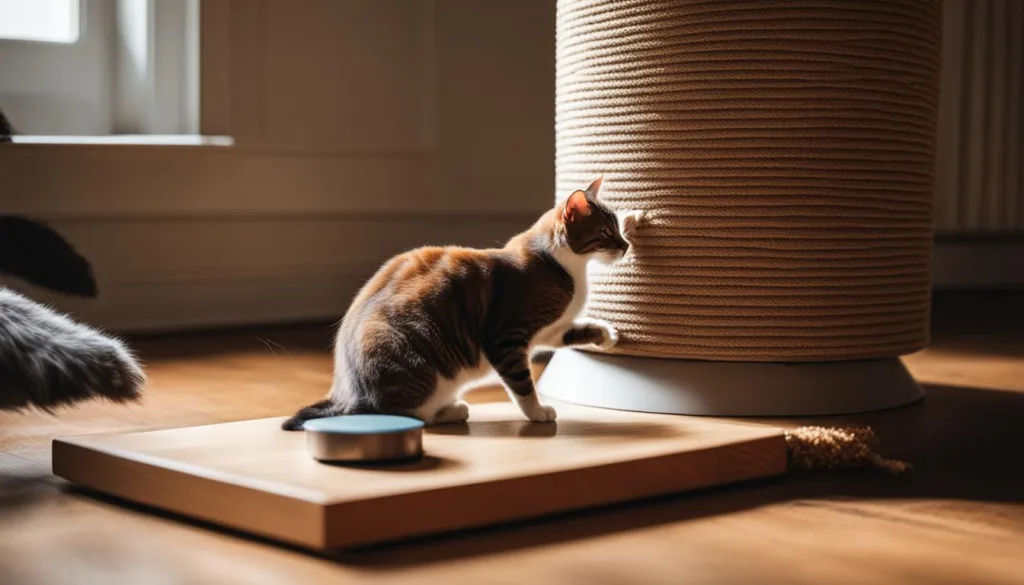
The Facts About Declawing
Declawing cats is a controversial and inhumane practice that should be avoided. It involves the amputation of a cat’s digits, which can lead to significant pain, behavior issues, and potential personality changes. Instead of resorting to declawing, there are more humane and effective solutions to prevent furniture scratching.
“Declawing is a last resort and should only be considered in extreme circumstances, such as medical necessity or when all alternative solutions have been exhausted,” says Dr. Jane Smith, a renowned veterinarian.
One of the key steps in preventing furniture scratching is providing appropriate scratching alternatives for your cat. Investing in a cat scratching post or tree can help redirect their natural scratching behavior onto an approved surface. Make sure to choose a sturdy and tall scratching post that allows your cat to fully extend their body for a satisfying scratch.
In addition to providing a scratching post, you can use cat scratching deterrents to protect your furniture. These deterrents come in the form of sprays, sticky tapes, or strips that you can apply to your furniture to make it less appealing for your cat to scratch. Combine these deterrents with positive reinforcement, such as treats and praise when your cat uses the scratching post, to reinforce the desired behavior.
| Effective Cat Scratch Prevention Methods | Pros | Cons |
|---|---|---|
| Provide a cat scratching post | Redirects scratching behavior, promotes exercise | May take time for cats to adjust, requires proper placement |
| Use cat scratching deterrents | Protects furniture, discourages scratching | May require reapplication, can have a temporary odor |
| Regular nail trims | Reduces the risk of scratching damage | Requires regular maintenance, may cause stress for some cats |
Remember, by providing appropriate scratching alternatives and using positive reinforcement, you can effectively prevent furniture scratching without resorting to declawing. Creating a cat-friendly environment and understanding your cat’s natural behavior will go a long way in promoting a happy and healthy cat.
Types of Leather and Their Vulnerability to Scratches
When it comes to cat scratching furniture, it’s important to understand the different types of leather and their vulnerability to scratches. This knowledge can help you determine the best approach to repairing and preventing scratches on your leather furniture.
One of the highest quality and most durable types of leather is full grain leather. However, even this type of leather can still be susceptible to scratches from cat claws. Another type of leather called top grain leather is sanded and finished to remove imperfections, making it relatively resistant to scratches. On the other hand, split leather, also known as corrected grain, is made from the lower layers of the hide and is the most affordable option. However, it is also the most vulnerable to scratches.
To better understand the vulnerability of each type of leather, here is a comprehensive table:
| Type of Leather | Vulnerability to Scratches |
|---|---|
| Full Grain Leather | High |
| Top Grain Leather | Moderate |
| Split Leather | Low |
As you can see from the table, full grain leather is the most vulnerable to scratches, while split leather is the least vulnerable. Understanding the type of leather your furniture is made of can help you take appropriate measures to repair and prevent scratches. Additionally, it’s worth considering your cat’s behavior and whether certain types of leather may be more tempting for scratching.
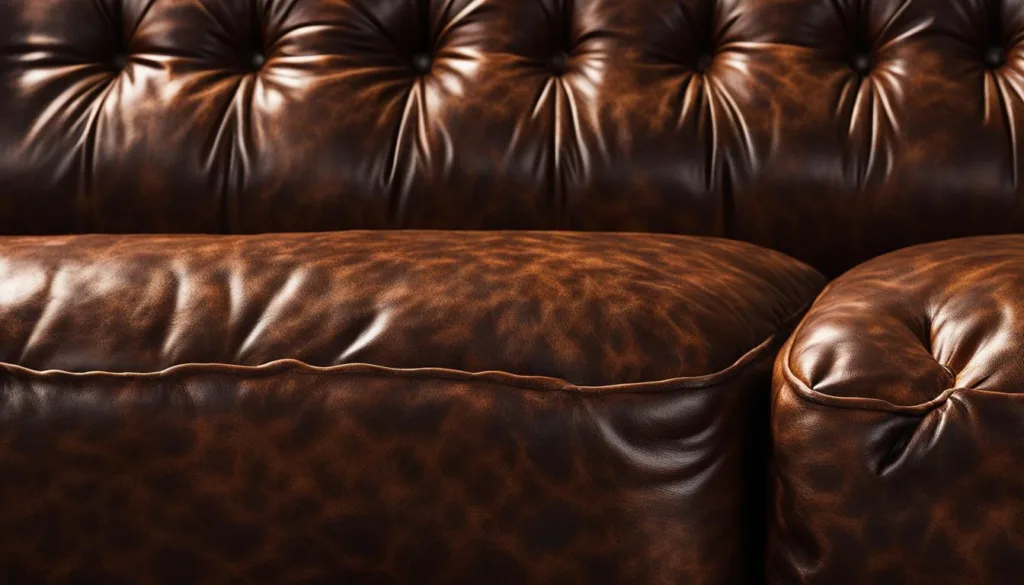
Conclusion
Knowing the vulnerability of different types of leather to scratches is essential in effectively protecting your furniture from cat scratching. Whether you have full grain leather, top grain leather, or split leather furniture, it’s important to provide appropriate scratching alternatives for your cat and redirect their behavior. By understanding the characteristics of your furniture’s leather and employing preventative measures, you can maintain a scratch-free environment and preserve the longevity of your leather furniture.
Assessing the Damage and Preparing for Repair
Before repairing cat scratches on leather furniture, it is crucial to assess the extent of the damage. By carefully examining the scratched areas, you can determine their size, depth, and location, which will help guide your repair efforts. Take note of any visible scratch marks on the leather surface, as well as any areas where the scratches may have penetrated deeper into the material.
Gathering the necessary tools and materials for repair is essential. A leather repair kit will typically contain items such as color matching compounds, adhesive, and grain papers. These components are designed to help you restore the damaged area and blend it seamlessly with the surrounding leather. Additionally, having a leather conditioner on hand is important, as it will help nourish and protect the leather after the repair is complete.
Before beginning the repair process, it’s essential to clean the leather surface thoroughly. Use a mild leather cleaner or a solution of warm water and gentle soap to remove any dirt, grime, or residue. Gently wipe the surface with a soft cloth, taking care not to scrub too harshly. Once the leather is clean and dry, it will be ready for the repair.

| Tools and Materials Needed for Leather Repair |
|---|
| Leather repair kit |
| Leather conditioner |
| Mild leather cleaner or soap solution |
| Soft cloth |
Home Remedies for Fixing Cat Scratches
When it comes to fixing cat scratches on leather furniture, there are several home remedies that can be effective for addressing superficial scratches. These remedies can help minimize the appearance of scratches and restore the overall look of your furniture. Here are some home remedies you can try:
Olive Oil and Vinegar Mixture
An olive oil and vinegar mixture can be applied to light scratches on leather. This combination can help reduce the visibility of scratches by moisturizing the leather and blending the colors. Simply mix equal parts olive oil and vinegar, then apply the solution to the scratches using a soft cloth. Gently rub the mixture into the scratches in a circular motion. Allow it to sit for a few minutes, then wipe away any excess solution with a clean cloth.
Leather Conditioner
Using a leather conditioner is another effective way to minimize the appearance of cat scratches. Leather conditioners work by softening the leather and filling in the scratch, making it less noticeable. Apply a small amount of leather conditioner to a soft cloth and gently rub it into the scratched area. Be sure to follow the manufacturer’s instructions for application and allow the conditioner to dry completely before using the furniture.
Shoe Polish or Cream
If you have darker colored leather furniture, shoe polish or cream can be used to disguise scratches and restore the color of the leather. Choose a shade that closely matches the color of your furniture and apply a small amount to the scratches using a soft cloth. Gently buff the polish or cream into the scratches until they are less visible. Remember to let the polish or cream dry completely before using the furniture.
It’s important to note that these home remedies are best suited for light scratches on leather furniture. If you have deeper or more severe scratches, it may be necessary to use a DIY repair kit or seek professional assistance. Additionally, always test any home remedy on a small, inconspicuous area of the furniture before applying it to the entire surface.
| Home Remedies | Effectiveness |
|---|---|
| Olive Oil and Vinegar Mixture | Minimizes visibility of light scratches |
| Leather Conditioner | Softens the leather and fills in scratches |
| Shoe Polish or Cream | Disguises scratches and restores color |
Diy Repair Kits for Cat Scratches
When it comes to repairing cat scratches on leather furniture, DIY repair kits can be a handy solution. These kits provide the necessary materials and instructions to effectively repair and restore the damaged leather, saving you the cost of professional repair services. Using a DIY repair kit allows you to take control of the repair process and achieve satisfactory results. Whether you’re dealing with superficial scratches or deeper gouges, these kits offer a comprehensive solution for fixing cat scratches on leather.
One of the key benefits of using a DIY repair kit is its convenience. The kit usually contains all the essential tools and materials needed for the repair process, such as color-matched fillers, adhesives, and applicators. With clear instructions provided, even beginners can easily follow the steps and successfully repair the damage. This makes it a cost-effective option compared to hiring a professional.
In addition to convenience, DIY repair kits also provide a long-lasting solution for cat scratches on leather. The fillers and adhesives included in the kit are designed to bond securely with the leather, ensuring a durable and seamless repair. By following the instructions and taking your time, you can achieve a professional-looking result that blends seamlessly with the rest of the leather.
Diy Repair Kit Comparison Table
| Kit Name | Key Features | Price Range |
|---|---|---|
| LeatherNu Complete Leather Color Restoration & Repair Kit | Includes color-matched fillers, adhesives, and applicators. Suitable for minor scratches and color touch-ups. | $30-$40 |
| Strongman Tools Leather Repair Pro 25 Piece Professional Leather and Vinyl Repair Kit | Comes with a wide range of tools and materials. Suitable for repairing various types of leather damage, including scratches, tears, and holes. | $50-$60 |
| Fortivo Leather and Vinyl Repair Kit | Includes all the necessary tools and materials for repairing scratches, cracks, tears, and burns on leather and vinyl surfaces. | $20-$30 |
It’s important to choose a DIY repair kit that is specifically designed for leather and provides the appropriate materials for the type of damage you’re dealing with. Reading product reviews and comparing features can help you make an informed decision. With the right DIY repair kit and a little patience, you can restore your leather furniture and say goodbye to cat scratches.
Conclusion
In conclusion, understanding the natural behavior of cats and providing appropriate scratching alternatives are crucial in preventing furniture scratching. Cats have a natural instinct to scratch for various reasons, including sharpening their claws, marking territory, and expressing emotions. By offering cat scratching posts, deterrents, and toys, cat owners can redirect their cat’s scratching behavior and protect their furniture.
It is important to avoid declawing as it is considered inhumane and can lead to behavior issues in cats. Instead, a step-by-step approach can be followed to prevent furniture scratching. This includes making the furniture less appealing by using cat scratching deterrents such as double-sided tape or aluminum foil, placing cat scratchers next to off-limits areas, and encouraging their use through play and treats.
If cat scratches do occur on leather furniture, there are home remedies and DIY repair kits available. Home remedies such as leather conditioner, olive oil and vinegar mixture, or shoe polish can help minimize the appearance of light scratches. For deeper scratches, DIY repair kits provide a more comprehensive and long-lasting solution.
With patience, proper care, and the implementation of these strategies, cat owners can create a happy and scratch-free environment for both their cats and furniture.
FAQ
Why do cats scratch?
Cats scratch to sharpen their claws, mark their territory, and express their emotions.
How can I prevent my cat from scratching furniture?
By offering cat scratching posts, deterrents, and toys, you can redirect their scratching behavior and protect your furniture.
Is declawing a humane solution to prevent furniture scratching?
No, declawing is considered inhumane and can lead to behavior issues in cats.
What are some supplies to stop cat scratching?
Cat scratching deterrents such as sticky paws furniture strips, double-sided sticky tape, and cat furniture repellents can be effective. Other household items like sheets, blankets, and aluminum foil can also be used. Providing cat scratchers, catnip, cat treats, and cat toys can help redirect the cat’s scratching behavior.
How can I stop my cat from scratching furniture step-by-step?
You can make the furniture less appealing by using cat scratching deterrents such as double-sided tape or aluminum foil. Place cat scratchers next to the off-limits area and encourage their use through play and treats. Gradually move the scratcher away from the furniture. Regular nail trims and positive reinforcement can also help discourage furniture scratching.
What are the facts about declawing?
Declawing is considered inhumane and should be avoided. It involves amputating part of the cat’s digits, leading to pain, behavior issues, and potential personality changes.
How does the type of leather affect vulnerability to scratches?
Full grain leather is the most durable, while top grain leather is relatively resistant to scratches. Split leather is the most affordable but also the most susceptible to scratches.
How do I assess the damage and prepare for leather repair?
Assess the extent of the damage by identifying scratched areas, determining the size and depth of the scratches, and noting their location. Gather the necessary tools and materials for repair, such as a leather repair kit, leather conditioner, and DIY solutions. Clean the leather surface to remove dirt and residue.
Are there any home remedies for fixing cat scratches on leather?
Yes, home remedies like leather conditioner, an olive oil and vinegar mixture, and shoe polish or cream can be used to minimize the appearance of light scratches and restore the color of the leather. However, they may not be suitable for deep gouges.
Can DIY repair kits fix deeper cat scratches on leather?
Yes, DIY repair kits can be used to fix deeper scratches on leather. These kits often come with instructions and materials for repairing and restoring the damaged area.
What is the importance of understanding cat behavior and providing appropriate scratching alternatives?
Understanding the natural behavior of cats and providing appropriate scratching alternatives is essential in preventing them from scratching furniture and promoting a healthy and happy cat.

